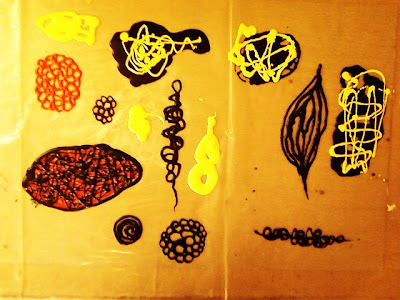The painting that I spent most time on didn't register well in the photo I took, probably because I glazed it in yellow again. I did have this one, though:
It's a 6" x 6" panel, with several layers of drawing separated by thick layers of clear tar gel. The drawing was mainly doodling, to see how the process would look, but in the end I quite like the picture anyway.
And before I left, I laid down a whole load of shapes in thick acrylic gels/paint, to use as collage elements when they are dried (they're on a plastic sheet so I can prise them free later):
 Subscribe to Praeterita in a reader
Subscribe to Praeterita in a reader
It's a 6" x 6" panel, with several layers of drawing separated by thick layers of clear tar gel. The drawing was mainly doodling, to see how the process would look, but in the end I quite like the picture anyway.
And before I left, I laid down a whole load of shapes in thick acrylic gels/paint, to use as collage elements when they are dried (they're on a plastic sheet so I can prise them free later):

